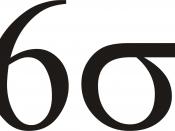A company's human resource is a core competency that competitors cannot copy, and the only one that can produce output whose value is greater than the sum of its parts. Employee satisfaction has a strong connection to customer satisfaction.
Prior to the Industrial Revolution, skilled craftspeople had a major risk in the quality of their products because their families' living depended on the sale of those products. Frederick W. Taylor changed the craftsmanship concept. He concluded that a factory should be managed on a scientific basis; however his system, upon which much of modern manufacturing is designed, failed to exploit the knowledge and creativity of the workforce. The Taylor system was the key force behind the explosive economic development of the 20th century, as it dramatically improved productivity. Total Quality and many other pioneers of scientific management have provided a new focus on the role of people in work.
Human Resource Management (HRM) consists of activities designed to provide for and coordinate all the people of an organization.
These include determining the organization's human resource needs; recruiting, selecting, developing, counseling, and rewarding employees; acting as a liaison between unions and government organizations; and handling other matters concerning employee well-being. HRM seeks to build a high performance workplace and maintain an environment for quality excellence.
Leading practices include promoting teamwork and skill sharing across work units and
locations; designing work and jobs to promote cooperation, initiative, empowerment, innovation, and the organization's culture; empowering individuals and teams; developing effective performance management systems, compensation, and reward and recognition approaches; empowering individuals and teams; effectively managing hiring and career progression processes; investing in training and education; motivating employees; maintaining a work environment conducive to the well-being and growth of all employees; and monitoring the effectiveness of HR practices along with measuring employee satisfaction.
Teams in Organizational Design and Quality Improvement
A team is a small number of people with complementary skills who are committed to a common purpose, set of performance goals, and approach for which they hold themselves mutually accountable. Common types of teams include:
* Management teams: teams consisting mainly of managers from various functions, such as sales and production that coordinate work among teams.
* Natural work teams: teams organized to perform entire jobs, rather than specialized, assembly line-type of work.
* Self-managed teams or self-directed work teams: specially empowered work teams defined trained group of employees, from 6 to 18, on average, fully responsible for turning out a well-defined segment of finished work.
* Virtual teams: teams communicate by computer, take turns as leaders, and jump in and out as necessary.
* Quality circles: teams of workers and supervisors that meet regularly to address work-related problems involving quality and productivity.
* Problem-solving teams: teams whose members gather to solve a specific problem and then split up.
* Project teams: teams with a specific mission to develop something new or to accomplish a complex task. They are a vital part of Six Sigma efforts as each member provides different levels of knowledge and expertise in guiding a Six Sigma project.
Management teams, natural work teams, self-managed teams, and virtual teams usually work on routine business activities and are an important part of how work is organized and designed. Quality circles, problem-solving teams, and project teams work more on an ad-hoc basis to address specific tasks or issues, often relating to quality improvement. Also, natural work teams, self-managed teams, and quality circles usually are intraorganizational, that is, members usually come from the same department or function. Management teams, problem-solving teams, virtual teams, and project teams, are usually cross-functional; they work on specific tasks or processes that cut across boundaries of several different departments of an organization.
The three basic functions of quality circles and problem-solving teams are to identify, analyze, and solve quality and productivity problems.
Building Effective Teams.
Building and developing successful teams requires solid management support and good planning. Self-managed teams, in particular are challenging because of the level of empowerment that they possess. The key stages of a team's life cycle are called:
1. Forming - it takes place when the team is introduced, meets together, and explores issues of their new assignment.
2. Storming - it takes place when team members disagree and challenge each other on the way the team will function.
3. Norming - it takes place when issues at the previous stage have been resolved and members agree on roles, ground rules, and acceptable behaviour during work.
4. Performing - team members cooperate to solve problems and complete the goals of their assigned work.
5. Adjourning - the team wraps up the project, satisfactorily completes its goals, and prepares to split up or move on to another project.
Understanding what makes successful teams can help remove obstacles to effective team development and smooth the transitioning process.
Six Sigma Project Teams.
1. Champions - senior-level managers who promote and lead the operation of Six Sigma in a significant area of the business. They understand the concept of Six Sigma, select projects, set objectives, allocate resources, and mentor teams.
2. Master Black Belts - full-time Six Sigma experts who are responsible for Six Sigma strategy training, mentoring, operation, and results. They work across the organization to develop and coach teams, conduct training and lead change, but are typically not members of Six Sigma project teams.
3. Black Belts: fully trained Six Sigma experts with up to 160 hours of training, who perform much of the technical analyses required of Six Sigma projects, usually on a full-time basis. They mentor and develop Green Belts.
4. Green Belts: functional employees who are trained in introductory Six Sigma tools and methodology and work on projects on a part-time basis.
5. Team Members: individuals from various functional areas who support specific projects.
Designing High-Performance Work Systems.
High performance work refers to work approaches used to systematically pursue ever-higher levels of overall organizational and human performance. In designing work systems, managers must make choices in five traditional areas of human resources - planning, staffing, appraising, compensating, and training and development.
Work and Job Design.
Work design refers to how employees are organized in formal and informal units, such as departments and teams. Job design refers to responsibilities and tasks assigned to individuals. Work and job design affect motivation, satisfaction, and organizational effectiveness.
The Hackman-Oldham model helps in understanding how job design impacts motivation, satisfaction, and organizational effectiveness. The model contains four major segments:
a. Critical psychological states - experienced meaningfulness (the need of workers to have the feeling that their work is a significant contribution to the organization and society), experienced responsibility (the need of workers to be accountable for the for the quality and quantity of work produced), and knowledge of results (all workers feel the need to know how their work is evaluated and the results of their evaluation).
b. Core job characteristics - task significance, task identity, skill variety, autonomy, and feedback from the job.
c. Moderating variables - variables, such as the current work environment or background that may affect the workers' motivation and outcome of their work.
d. Outcomes - the key outcomes of high general job satisfaction and high work effectiveness can then be seen as results that define and reinforce excellent quality.
Moderator approaches such as, job enlargement (workers' jobs are expanded to include several tasks rather than one single, low-level task), job rotation (a technique by which workers learn several tasks by rotating from one to another), and job enrichment (workers are given more authority, responsibility and autonomy in their work) support TQ principles.
Employee involvement (EI) refers to any activity by which employees participate in work-related decisions and improvement activities. Although not new, EI approaches support TQ principles by developing trust, encouraging cooperation, and developing leadership abilities. The Suggestion system is a set of simple ways to involve employees in improvement activities.
Empowerment - giving employees authority and autonomy to make decisions - has been supported by quality leaders such as Juran and Deming. However, it requires significant changes in work systems, and requires managers to view work much differently. Empowerment often requires a substantial commitment to training and education, one of the hallmarks of TQ organizations.
Managing human resources in a TQ environment requires increased attention to recruitment and career development; training and education; compensation and recognition; health, safety, and well-being; motivation; performance appraisal; and measuring and evaluating HRM effectiveness.
Compensation and recognition refer to all aspects of pay and reward, including promotions, bonuses, and both monetary and non-monetary forms of recognition. Extrinsic (trips, clothing) and intrinsic (time off or special company-sponsored awards and events) rewards are important to sustaining employee motivation. Team-based pay and gain sharing (an approach in which all employees share savings equally) are prevalent in TQ organizations, as are a variety of non-monetary recognition approaches.
Motivation is an individual's response to a felt need. Many long-standing theories of motivation have important implications in TQ organizations, and need to be understood by all levels of managers. Content, process, and environmentally-based theories and models provide a theoretical basis for managerial leadership.
Performance appraisal is a process for evaluating and generating information about employees' effectiveness and efficiency at work. Traditional performance appraisal processes often are at odds with a TQ philosophy. Performance appraisal should be based on quality-related issues, problem identification, coaching, and continuous improvement rather than being tied to compensation and merit-rating systems. One approach, 360-degree feedback, focuses on two-way communication between employees and customers, suppliers, managers, subordinates, and peers to discuss goals and performance appraisals. Many companies are now replacing performance appraisal with planning and development systems that often focus on core competencies and mastery descriptions (descriptions of behaviour that one has mastered it would likely engage in it) to describe the behavior that employees should engage in.
To assess the linkages with strategy and to provide a foundation for improvement, measurement of employee satisfaction and HRM effectiveness is necessary. Typical measures include outcomes such as productivity improvement, defect reduction, employee turnover, and perceptions of behavioral performance; and process measures, such as suggestion rates and problem-solving effectiveness. Employee perceptions are usually measured through surveys.
HRM practices in the Internet Age often requires employers to take non-traditional approaches to attract and retain high-skilled employees. This may include special perks, increased levels of responsibility early in the employee's career, and understanding of the effects of changes brought about by new technologies and new realities of employee lifestyles in the 21st Century.



Good
an essay with bundles of information on the subject
1 out of 1 people found this comment useful.